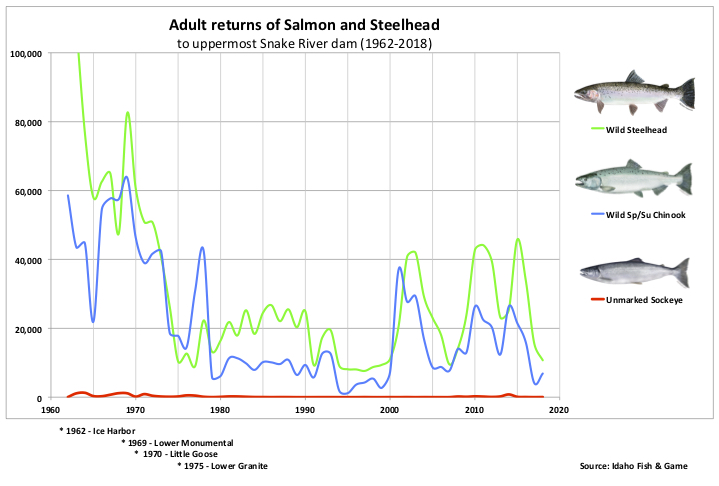forum
library
tutorial
contact

Snake River Steelhead Outlook:
Ho Hum for Now
by Eric Barker
Lewiston Tribune, July 15, 2022
|
the film forum library tutorial contact |

|
Snake River Steelhead Outlook:
by Eric Barker
|
Ocean conditions scored 2021 as the second best in a 24-year data set
 Spring chinook and sockeye returning to the Columbia River have surprised and delighted anglers and fisheries managers alike by exceeding official forecasts.
Spring chinook and sockeye returning to the Columbia River have surprised and delighted anglers and fisheries managers alike by exceeding official forecasts.
Steelhead are up next. Can we expect them to ride the same wave of productive ocean conditions and overachieve as well?
Fisheries managers hope so but aren't necessarily betting on it.
Tribal, state and federal fisheries managers are forecasting a return of 96,600 steelhead bound for tributaries of the Columbia River to pass Bonneville Dam. That includes 81,000 A-run fish that tend to spend one-year in the ocean and 15,600 B-run fish that average two years in salt water.
That isn't a great return, just 59% of the 10-year average, and that average has dropped precipitously over the past decade. It was 370,764 in 2012 and just 193,622 last year.
Chris Sullivan, anadromous fish manager for the Idaho Department of Fish and Game at Boise, described the forecast as "nothing spectacular."
He said about 51,400 steelhead are expected to make it at least as far as Lower Granite Dam on the Snake River. That includes 40,500 A-run fish and 10,900 B-run fish. Of those, about 36,000 will be of hatchery origin and 15,000 wild.
"We are less than 5% through (the run) down at Bonneville, so we don't really have much of an indication of how we are looking compared to the preseason forecast," he said. "The counts at Bonneville to date are tracking about in line with the 10-year average, which would result in more steelhead than our preseason forecast."
Chris Donley, fish program manager for the Washington Department of Fish and Wildlife, views it the same way and is "cautiously optimistic" the fish will exceed the forecast.
"They are tracking with the 10-year average, and the 10-year average is nowhere near record runs, but it looks like at a minimum, a slight rebound," he said. "I'm confident in saying we are going to at least hit the forecast and I'm optimistic we will be over forecast."
Scientists from the National Oceanic and Atmospheric Administration who track ocean conditions scored 2021 as the second best in a 24-year data set and the best over that time span for northern copepods -- a fat-rich organism near the bottom of the ocean food chain.
Sockeye and spring chinook seemed to have benefitted. Last winter, fisheries managers forecast 2022 would see a return of 198,700 sockeye. In an update issued this week, they tripled the sockeye forecast to 636,500. Similarly they predicted 123,000 upriver spring chinook would return at least as far as the mouth of the Columbia and later amended that to 192,600.
So shouldn't we expect steelhead will do better than forecast as well? The answer is maybe. Fisheries managers aren't willing to go too far out on a limb because they know steelhead behavior is different.
"We do know steelhead utilize a different portion of the Pacific Ocean than those other species," Sullivan said. "What is good for one is not necessarily good for another. But it leaves us hopeful things are going to be on the upswing."
Chinook, for instance, tend to turn right once they hit the ocean and hug the coast of Washington, British Columbia and Alaska before circling back south. Steelhead head straight out to sea.
learn more on topics covered in the film
see the video
read the script
learn the songs
discussion forum
